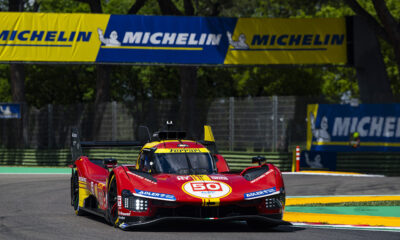The FIA World Endurance Championship’s new-look Balance of Performance system for the Hypercar class is designed to “bring more stability” to the top-category grid according to the FIA’s Director of Circuit Sport Marek Nawarecki.
The 2023 season, which kicks off at Sebring International Raceway on Friday, marks the first in which cars from the LMH and LMDh platforms will compete against each other.
Two key things that are new in the Hypercar BoP are the stability of values over multiple rounds and the added option for so-called ‘platform BoP’ changes every two races.
The FIA and ACO started out the season by publishing a BoP table for Sebring and a slightly different one for the next three rounds including the 24 Hours of Le Mans.
The idea is that the per-car values, including weight, power and energy usage per stint, will only change again after the French endurance classic.
Additionally, the option is open for the BoP values of an entire platform to change every two races, if deemed necessary. Hybrid and non-hybrid LMHs are in the same platform.
“[There was a] common agreement we reached with all manufacturers about the way to apply the BoP with the [purpose] to bring more stability in the whole process,” said Nawarecki.
“Previously, we had many iterations of the BoP that had less stability. Of course, that was a different approach, but it’s different also in this manner.
“Once we rely on what has been measured and evaluated as the potential [performance], we keep it stable over the season.
“It is also important to have a window for review, but we have the most equal situation. Everybody accepts that.
“There is more room for racing and for the manufacturers to express themselves in terms of how they use this potential on the track.”
Previously, a BoP table was published ahead of each race based on two rounds’ worth of data, but now the system is designed to be more consistent over the season.
“There is a starting BoP which will be applied in Sebring,” explained ACO competition director Thierry Bouvet.
“We also published the BoP for the following events, meaning we will not change the BoP [until] after Le Mans. It means everything is set and we can just let the manufacturers enjoy racing.
“A lot of effort has been done on our side — sorry to insist on that — but it was a good atmosphere and big push on our side to get it right.
“We believe we’ve done a good amount of work, and hopefully we see the results in the track. That’s how we’ve done this updated process in 2023.”
The FIA and ACO determine the Hypercar BoP using the potential performance data of each car, rather than lap times or qualifying performances. More than 500,000 simulations were conducted by the two governing bodies and IMSA prior to the start of the season.
“We simulate plenty of things,” said Bouvet. “Weight, power, deployment speed… all that is taken into account.”
Nawarecki added: “That doesn’t mean that we capture everything because it’s impossible.
“It’s like each car has its own strategy: they can have different settings and different choices for the races. That can make the difference.
“It is not the purpose of the BoP to capture this kind of thing. It’s part of the true racing.”
Manufacturers On Board With Updated System
Hypercar manufacturers from both LMH and LMDh have voiced support for the new-look Hypercar BoP.
Toyota Gazoo Racing technical director Pascal Vasselon told Sportscar365 that the stabilization of BoP values for multiple races “makes life much easier” for manufacturers.
Toyota has been through various iterations of equalization and balancing in the WEC, including Equivalence of Technology, success handicaps, and last season’s Hypercar BoP with a grandfathered LMP1 car factored in.
“One of the benefits of this fixed BoP is that there is no incentive anymore for sandbagging,” Vasselon said.
“In the past years, there were a lot of stories about sandbagging which was really bad for everyone. Now, there is no incentive anymore for sandbagging.
“The rationale is to balance the potential of the cars and then to stay stable with this balance.”
The factory director of Porsche’s LMDh program is also positive about the approach taken towards a BoP that manages different, but converged, prototype platforms.
“We really trust the system and the governance bodies with the decisions they take and how they do it,” Urs Kuratle told Sportscar365.
“The system, how they do it, we definitely trust in that process and we’re happy with what we’ve seen so far.
Commenting on the option for platform BoP changes, Kuratle said: “I think that’s reasonable. But there’s a chance to do that, whether it’s necessary or not, that will be proven.
“But the first one [could] be after the Portimao race effectively for the Spa race. I think that’s sensible because it’s all new to all of us.
“We all rely on the simulation, but we trust that’s the right way to do [things], especially we at Porsche, we trust this is the right way to do it. We are confident that it works.”
John Dagys contributed to this report


























